open hood LEXUS LS500H 2020 Owners Manual
[x] Cancel search | Manufacturer: LEXUS, Model Year: 2020, Model line: LS500H, Model: LEXUS LS500H 2020Pages: 516, PDF Size: 10.38 MB
Page 2 of 516
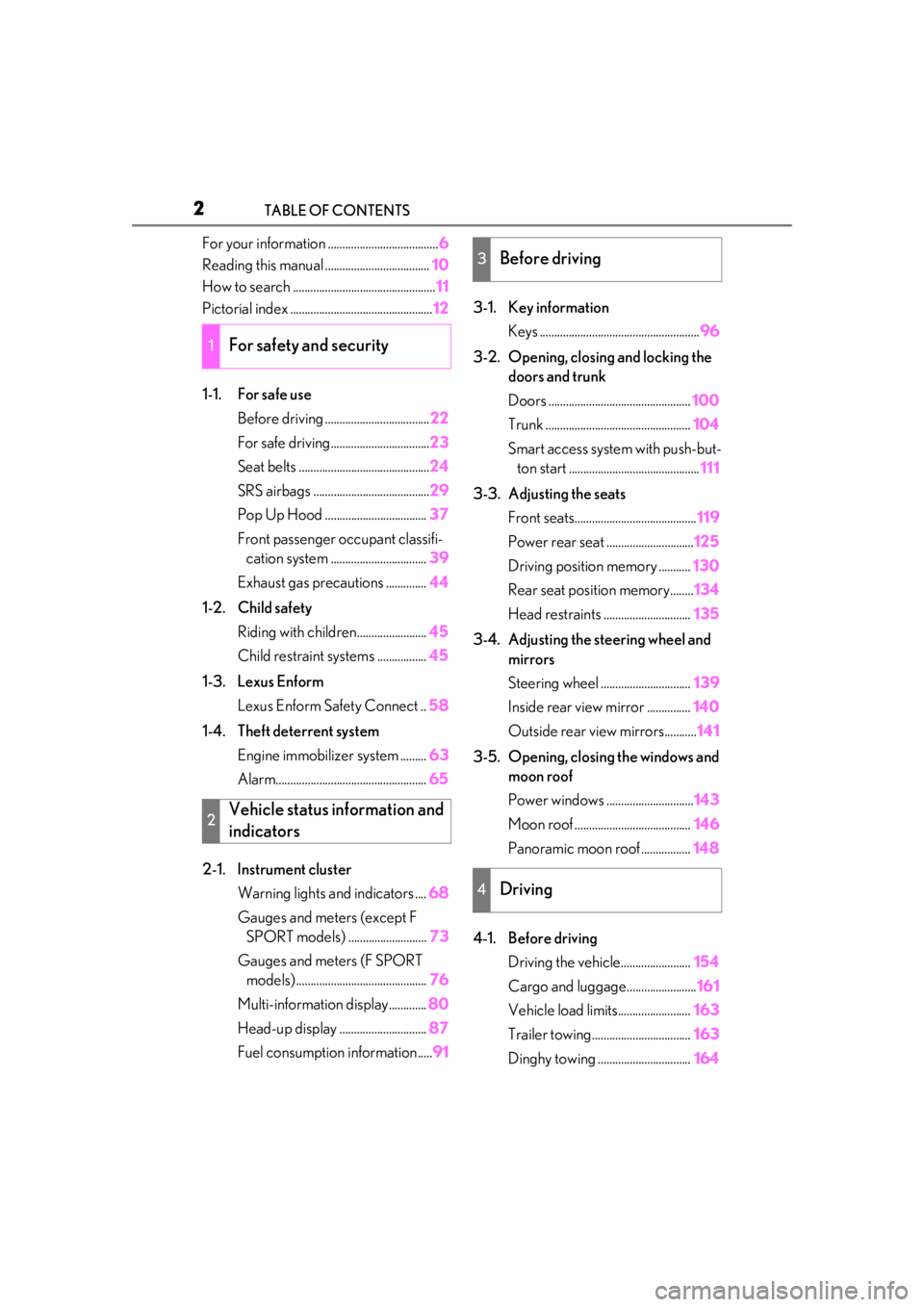
2TABLE OF CONTENTS
For your information ......................................6
Reading this manual .................................... 10
How to search ................................................. 11
Pictorial index ................................................. 12
1-1. For safe use Before driving .................................... 22
For safe driving.................................. 23
Seat belts ............................................. 24
SRS airbags ........................................ 29
Pop Up Hood ................................... 37
Front passenger occupant classifi- cation system ................................. 39
Exhaust gas precautions .............. 44
1-2. Child safety Riding with children........................ 45
Child restraint systems ................. 45
1-3. Lexus Enform Lexus Enform Safety Connect .. 58
1-4. Theft deterrent system Engine immobilizer system ......... 63
Alarm.................................................... 65
2-1. Instrument cluster Warning lights and indicators .... 68
Gauges and meters (except F SPORT models) ........................... 73
Gauges and meters (F SPORT models) ............................................. 76
Multi-information display............. 80
Head-up display .............................. 87
Fuel consumption information ..... 913-1. Key information
Keys ....................................................... 96
3-2. Opening, closing and locking the doors and trunk
Doors ................................................. 100
Trunk .................................................. 104
Smart access system with push-but- ton start ............................................. 111
3-3. Adjusting the seats Front seats.......................................... 119
Power rear seat .............................. 125
Driving position memory ........... 130
Rear seat position memory........ 134
Head restraints .............................. 135
3-4. Adjusting the steering wheel and mirrors
Steering wheel ............................... 139
Inside rear view mirror ............... 140
Outside rear view mirrors........... 141
3-5. Opening, closing the windows and moon roof
Power windows .............................. 143
Moon roof ........................................ 146
Panoramic moon roof ................. 148
4-1. Before driving Driving the vehicle........................ 154
Cargo and luggage........................ 161
Vehicle load limits......................... 163
Trailer towing.................................. 163
Dinghy towing ................................ 164
1For safety and security
2Vehicle status information and
indicators
3Before driving
4Driving
Page 4 of 516

4TABLE OF CONTENTS
5-6. Using the other interior featuresOther interior features .............. 346
Garage door opener.................. 354
6-1. Maintenance and care Cleaning and protecting the vehi-cle exterior ................................... 362
Cleaning and protecting the vehi- cle interior .................................... 365
6-2. Maintenance Maintenance requirements ..... 368
General maintenance ................ 369
Emission inspection and mainte- nance (I/M) programs ............ 372
6-3. Do-it-yourself maintenance Do-it-yourself service precautions........................................................... 373
Hood.................................................. 375
Positioning a floor jack............... 375
Engine compartment.................. 377
Battery .............................................. 385
Tires ................................................... 387
Replacing the tire ......................... 395
Tire inflation pressure ................. 399
Wheels.............................................. 400
Air conditioning filter..................402
Electronic key battery ................ 403
Checking and replacing fuses ........................................................... 405
Light bulbs ....................................... 4087-1. Essential information
Emergency flashers ..................... 410
If your vehicle has to be stopped in an emergency ............................. 410
If the vehicle is trapped in rising water ................................................. 411
7-2. Steps to take in an emergency If your vehicle needs to be towed............................................................ 413
If you think something is wrong ............................................................ 417
Fuel pump shut off system ......... 418
If a warning light turns on or a warn- ing buzzer sounds...................... 419
If a warning messa ge is displayed
.......................................................... 429
If you have a flat tire .................... 433
If the engine will not start .......... 434
If you lose your keys.................... 436
If the fuel filler door cannot be opened .......................................... 436
If the electronic key does not oper- ate properly ................................. 437
If the vehicle battery is discharged .......................................................... 439
If your vehicle overheats ........... 444
If the vehicle becomes stuck ... 447
8-1. Specifications Maintenance data (fuel, oil level, etc.) ................................................. 450
Fuel information............................ 459
6Maintenance and care
7When trouble arises
8Vehicle specifications
Page 13 of 516
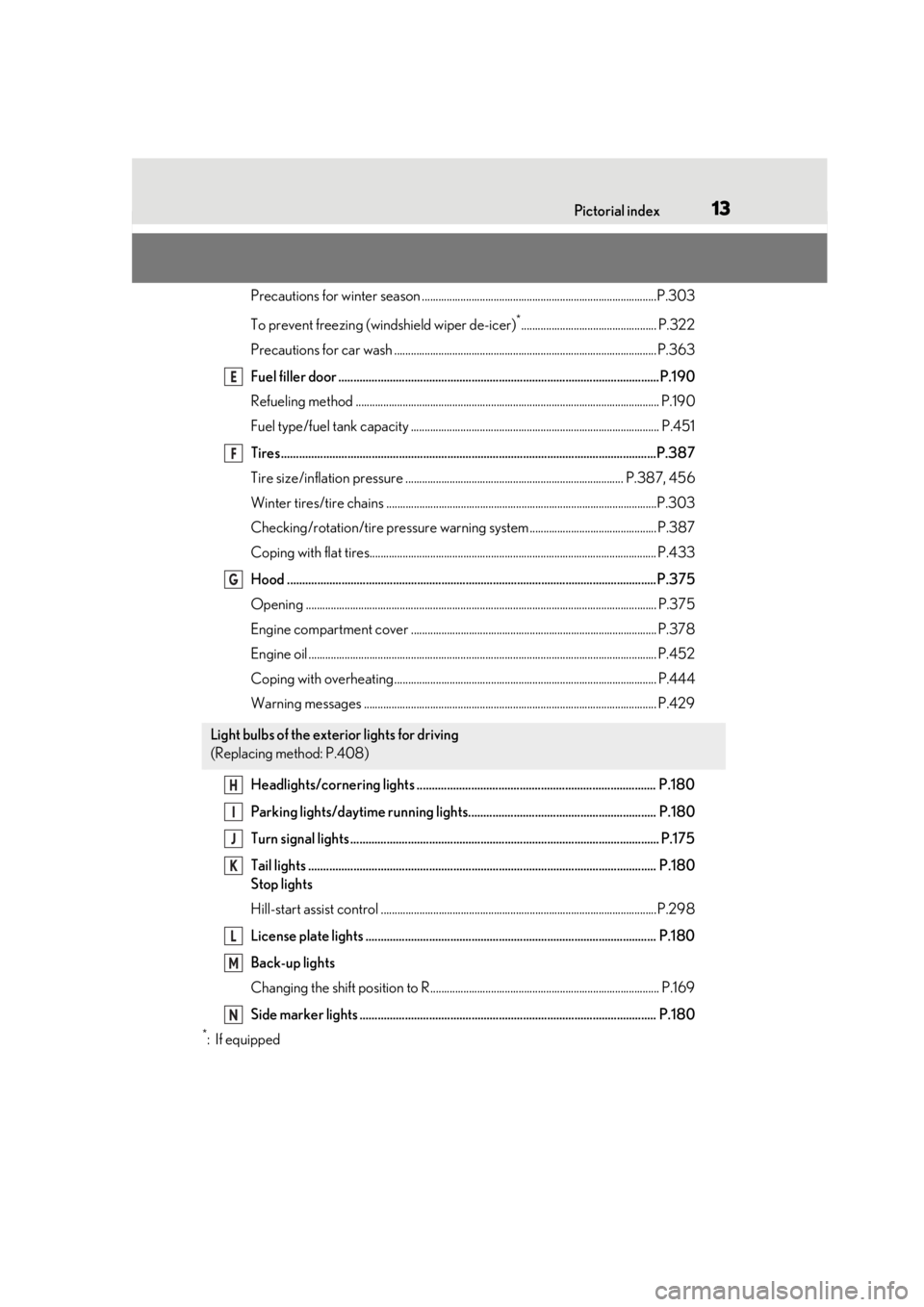
13Pictorial index
Precautions for winter season .....................................................................................P.303
To prevent freezing (windshield wiper de-icer)
*................................................. P.322
Precautions for car wash ............................................................................................... P.363
Fuel filler door ..........................................................................................................P.190
Refueling method .............................................................................................................. P .190
Fuel type/fuel tank capacity ...... .................................................................................... P.451
Tires.......................................................................................................................... ..P.387
Tire size/inflation pressure ............................ ................................................... P.387, 456
Winter tires/tire chains ..................................................................................................P.303
Checking/rotation/tire pressure warning system.............................................. P.387
Coping with flat tires........................................................................................................ P .433
Hood .......................................................................................................................... P.375
Opening ........................................................................................................................ ....... P.375
Engine compartment cover ......................................................................................... P.378
Engine oil ..................................................................................................................... ......... P.452
Coping with overheating ............................................................................................... P.444
Warning messages .......................................................................................................... P.429
Headlights/cornering lights ............................................................................... P.180
Parking lights/daytime running lights.............................................................. P.180
Turn signal lights ...................................................................................................... P.175
Tail lights ................................................................................................................... P .180
Stop lights
Hill-start assist control ....................................................................................................P. 298
License plate lights ................................................................................................ P.180
Back-up lights
Changing the shift position to R................................................................................... P.169
Side marker lights .................................................................................................. P.180
*:If equipped
Light bulbs of the exterior lights for driving
(Replacing method: P.408)
E
F
G
H
I
J
K
L
M
N
Page 15 of 516

15Pictorial index
Applying/releasing the parking brake.......................................................................P.176
Precautions for winter season .....................................................................................P.304
Warning buzzer/messages.......................................................................................... P.429
Turn signal lever ...................................................................................................... P.175
Headlight switch..................................................................................................... P.180
Headlights/parking lights/tail lights/license plate lig hts/daytime running lights
............................................................................................................................... .................... P.180
AHB (Automatic High Beam)...................................................................................... P.183
Windshield wiper and washer switch ................................................................P.185
Usage.......................................................................................................................... ............ P.185
Adding washer fluid .........................................................................................................P.3 84
Warning messages .......................................................................................................... P.429
Emergency flasher switch ....................................................................................P.410
Hood lock release lever ....................................................................................... P.375
Tilt and telescopic steering contro l switch................................ .................... .. P.139
Adjustment ..................................................................................................................... ...... P.139
Driving position memory ................................................................................................ P.130
Air conditioning system ........................................................................................ P.317
Usage.......................................................................................................................... .............P.317
Rear window defogger.....................................................................................................P.317
Audio system
*
Brake hold switch .................................................................................................... P.178
Trunk opener main switch ..................................................................................... P.110
*: Refer to “NAVIGATION AND MULTIMEDIA SYSTEM OWNER’S MANUAL”.
F
G
H
I
J
K
L
M
N
Page 45 of 516

451-2. Child safety
1
For safety and security
1-2.Child safety
Points to remember: P.45
Child restraint system: P.46
When using a child restraint system:
P.47
Child restraint system installation
method
• Fixed with a seat belt: P.49
• Fixed with a child restraint LATCH anchor: P.53
• Using an anchor bracket (for top tether strap): P.55
The laws of all 50 states of the U.S.A.
as well as Canada now require the use
of child restraint systems.
Prioritize and observe the warn-
ings, as well as the laws and regula-
Riding with children
Observe the following precautions
when children are in the vehicle.
Use a child restraint system appro-
priate for the child , until the child
becomes large enough to properly
wear the vehicle’s seat belt.
It is recommended that children
sit in the rear seats to avoid acci-
dental contact with the shift lever,
wiper switch etc.
Use the rear door child-protector
lock or the window lock switch to
avoid children opening the door
while driving or operating the
power window accidentally.
( P.103, 145)
Do not let small children operate
equipment which may catch or
pinch body parts, such as the
power window, hood, trunk, seats
etc.
WARNING
■When children are in the vehicle
Never leave children unattended in the
vehicle, and never allow children to have
or use the key.
Children may be able to start the vehicle
or shift the vehicle into neutral. There is
also a danger that children may injure
themselves by playing with the windows,
the moon roof or panoramic moon roof,
or other features of the vehicle. In addi-
tion, heat build-up or extremely cold
temperatures inside the vehicle can be
fatal to children.
Child restraint systems
Before installing a child restraint
system in the vehicle, there are pre-
cautions that need to be observed,
different types of child restraint sys-
tems, as well as installation meth-
ods, etc., written in this manual.
Use a child restraint system when
riding with a small child that cannot
properly use a seat belt. For the
child’s safety, install the child restraint
system to a rear seat. Be sure to fol-
low the installation method that is in
the operation manual enclosed with
the restraint system.
Table of contents
Points to remember
Page 65 of 516
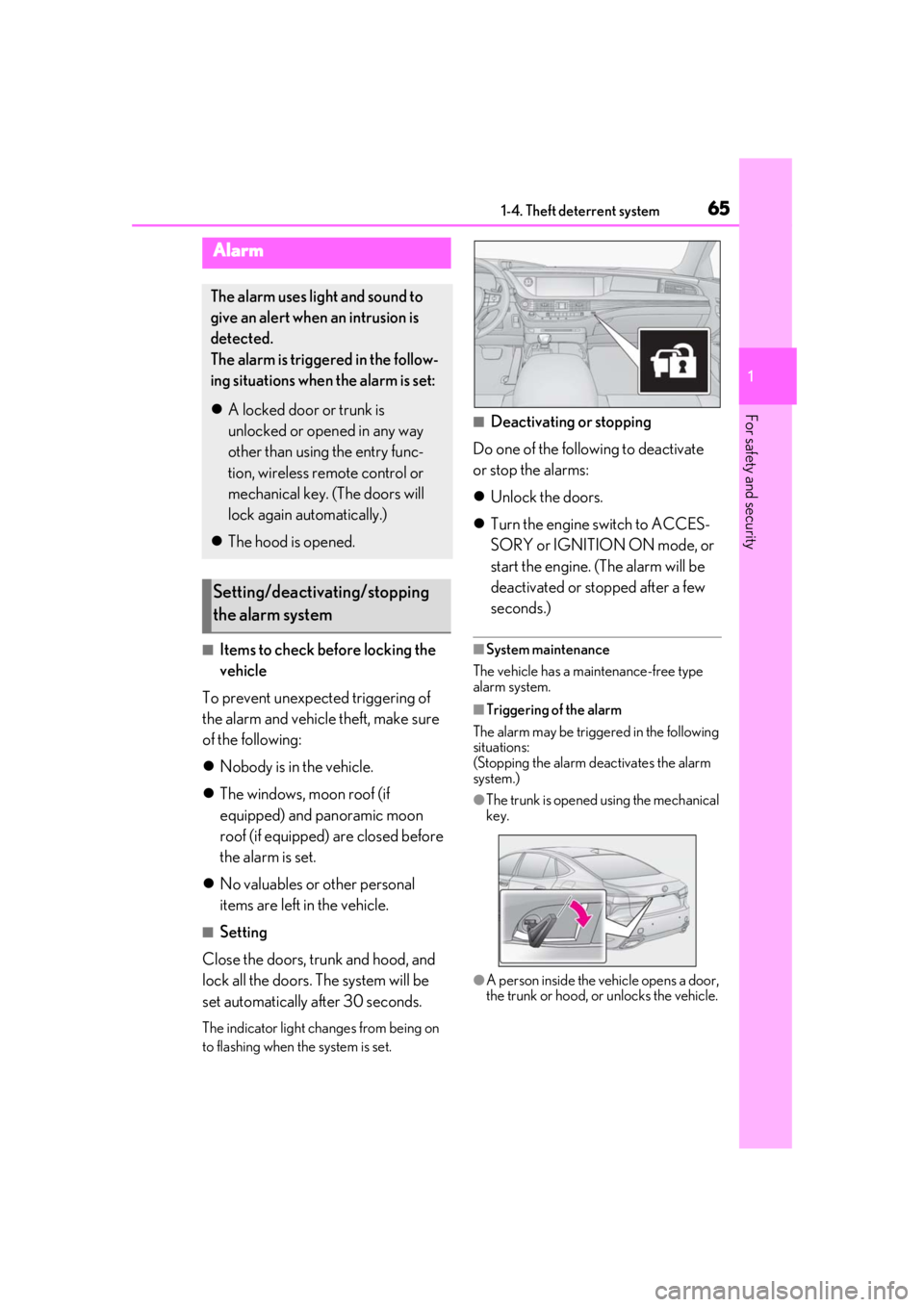
651-4. Theft deterrent system
1
For safety and security
■Items to check before locking the
vehicle
To prevent unexpected triggering of
the alarm and vehicle theft, make sure
of the following:
Nobody is in the vehicle.
The windows, moon roof (if
equipped) and panoramic moon
roof (if equipped) are closed before
the alarm is set.
No valuables or other personal
items are left in the vehicle.
■Setting
Close the doors, trunk and hood, and
lock all the doors. The system will be
set automatically after 30 seconds.
The indicator light changes from being on
to flashing when the system is set.
■Deactivating or stopping
Do one of the following to deactivate
or stop the alarms:
Unlock the doors.
Turn the engine switch to ACCES-
SORY or IGNITION ON mode, or
start the engine. (The alarm will be
deactivated or stopped after a few
seconds.)
■System maintenance
The vehicle has a maintenance-free type
alarm system.
■Triggering of the alarm
The alarm may be triggered in the following
situations:
(Stopping the alarm deactivates the alarm
system.)
●The trunk is opened using the mechanical
key.
●A person inside the vehicle opens a door,
the trunk or hood, or unlocks the vehicle.
Alarm
The alarm uses light and sound to
give an alert when an intrusion is
detected.
The alarm is triggered in the follow-
ing situations when the alarm is set:
A locked door or trunk is
unlocked or opened in any way
other than using the entry func-
tion, wireless remote control or
mechanical key. (The doors will
lock again automatically.)
The hood is opened.
Setting/deactivating/stopping
the alarm system
Page 198 of 516
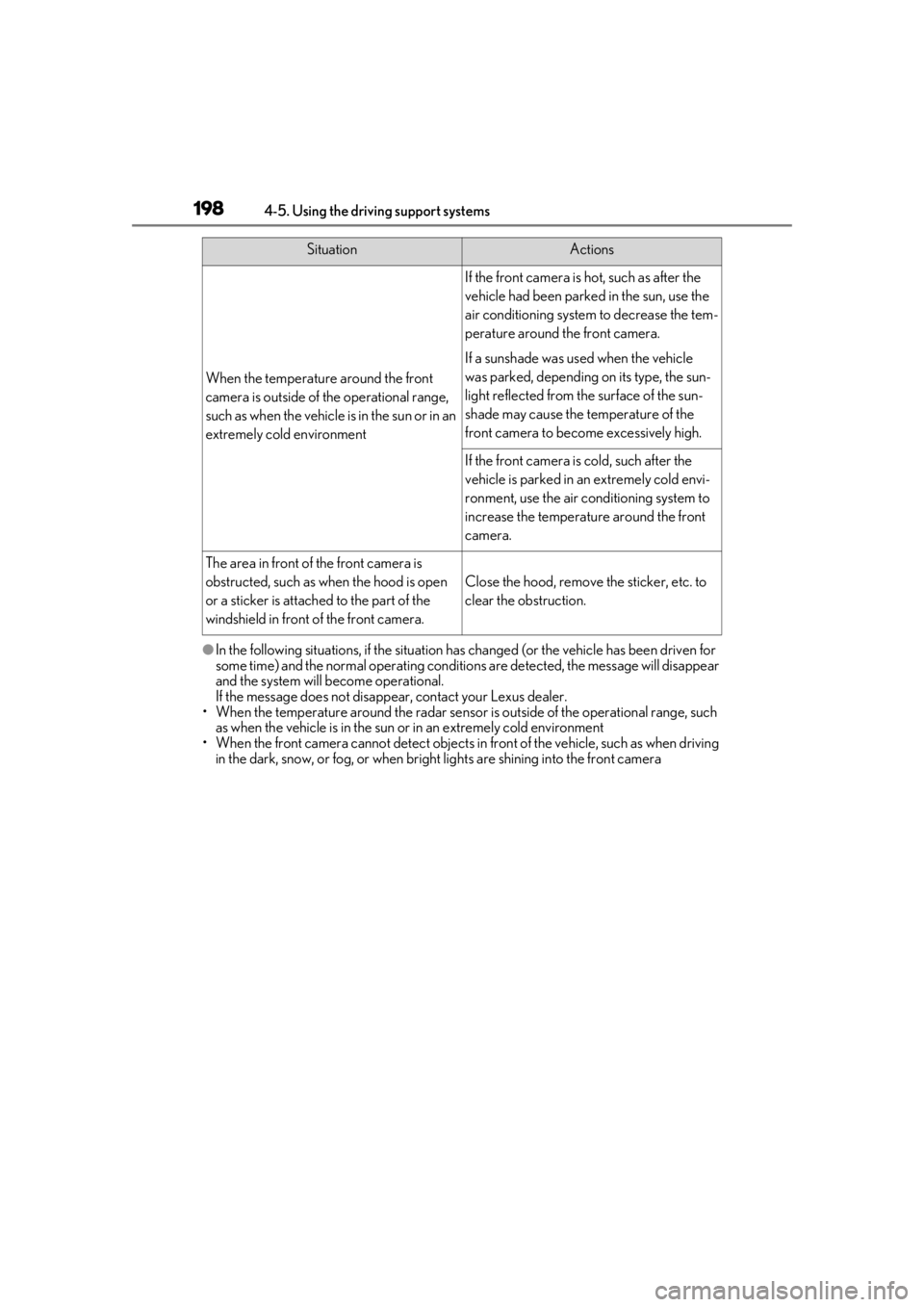
1984-5. Using the driving support systems
●In the following situations, if the situation has changed (or the vehicle has been driven for
some time) and the normal operating conditions are detected, the message will disappear
and the system will become operational.
If the message does not disappear, contact your Lexus dealer.
• When the temperature around the radar sensor is outside of the operational range, such
as when the vehicle is in the sun or in an extremely cold environment
• When the front camera cannot detect objects in front of the vehicle, such as when driving
in the dark, snow, or fog, or when brig ht lights are shining into the front camera
When the temperature around the front
camera is outside of the operational range,
such as when the vehicle is in the sun or in an
extremely cold environment
If the front camera is hot, such as after the
vehicle had been parked in the sun, use the
air conditioning system to decrease the tem-
perature around the front camera.
If a sunshade was used when the vehicle
was parked, depending on its type, the sun-
light reflected from the surface of the sun-
shade may cause the temperature of the
front camera to become excessively high.
If the front camera is cold, such after the
vehicle is parked in an extremely cold envi-
ronment, use the air conditioning system to
increase the temperature around the front
camera.
The area in front of the front camera is
obstructed, such as when the hood is open
or a sticker is attached to the part of the
windshield in front of the front camera.
Close the hood, remove the sticker, etc. to
clear the obstruction.
SituationActions
Page 204 of 516
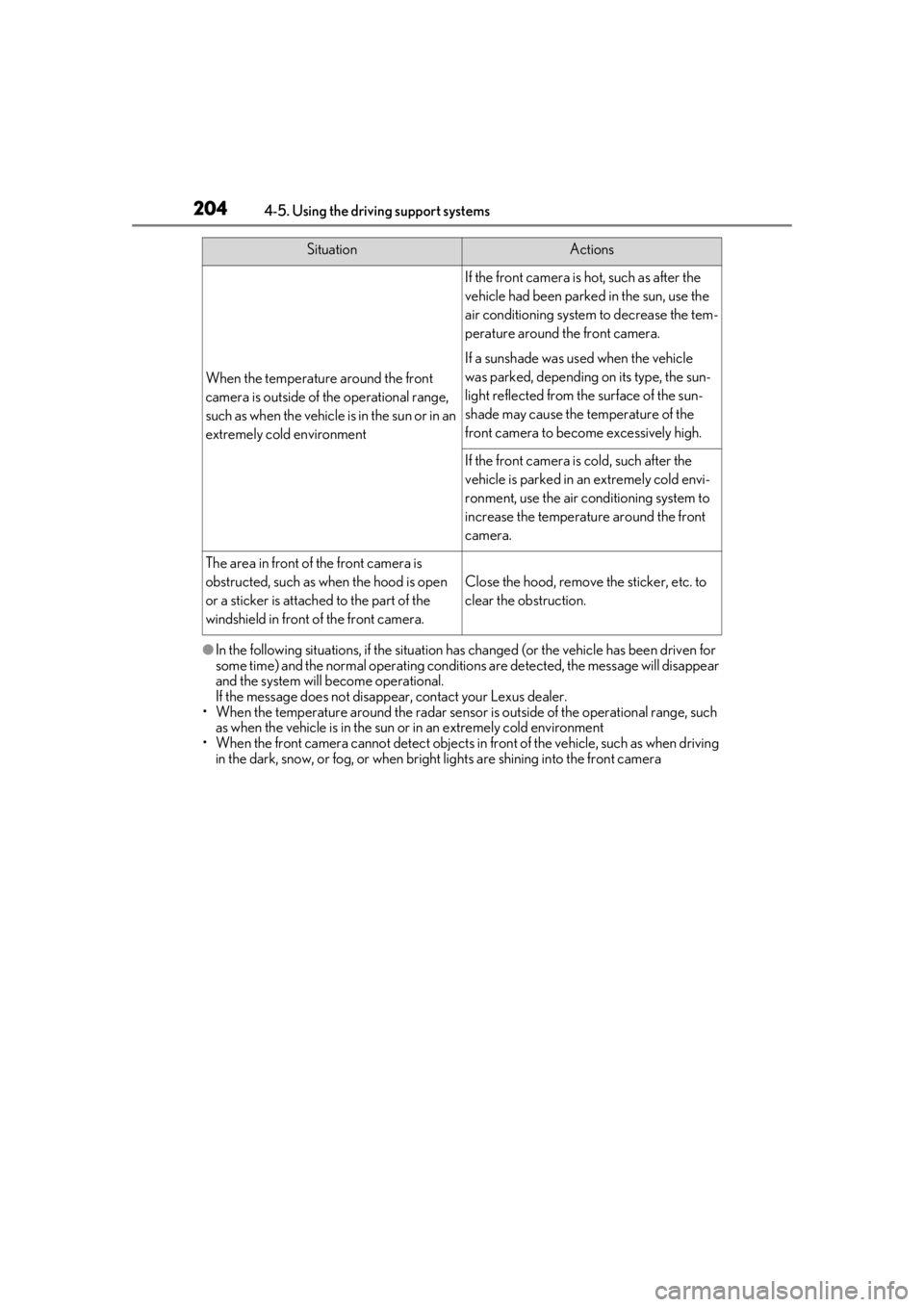
2044-5. Using the driving support systems
●In the following situations, if the situation has changed (or the vehicle has been driven for
some time) and the normal operating conditions are detected, the message will disappear
and the system will become operational.
If the message does not disappear, contact your Lexus dealer.
• When the temperature around the radar sensor is outside of the operational range, such
as when the vehicle is in the sun or in an extremely cold environment
• When the front camera cannot detect objects in front of the vehicle, such as when driving
in the dark, snow, or fog, or when brig ht lights are shining into the front camera
When the temperature around the front
camera is outside of the operational range,
such as when the vehicle is in the sun or in an
extremely cold environment
If the front camera is hot, such as after the
vehicle had been parked in the sun, use the
air conditioning system to decrease the tem-
perature around the front camera.
If a sunshade was used when the vehicle
was parked, depending on its type, the sun-
light reflected from the surface of the sun-
shade may cause the temperature of the
front camera to become excessively high.
If the front camera is cold, such after the
vehicle is parked in an extremely cold envi-
ronment, use the air conditioning system to
increase the temperature around the front
camera.
The area in front of the front camera is
obstructed, such as when the hood is open
or a sticker is attached to the part of the
windshield in front of the front camera.
Close the hood, remove the sticker, etc. to
clear the obstruction.
SituationActions
Page 294 of 516

2944-5. Using the driving support systems
*: If equipped
■Situations in which the vehicle height
control may not operate properly
●In the following situations, the vehicle
height may change slowly or may not
change to the correct height:
• When the vehicle comes into contact with snow, ice, stone, etc.
• When the ambient temperature is low
• When the accumulator tank pressure is low
●In the following situations, the vehicle
height may not change:
• If the hood or trunk is not fully closed
• If the brake pedal depressed and the
vehicle is stopped
• When the vehicle is on a significantly
uneven or undulating road
• When the vehicle is on a slanted road or a slope
■Operating sound of the air suspension
compressor and valves
In the following situations the air suspension
compressor and valves may operate and a
sound may be heard, but this does not indi-
cate a malfunction.
●When passengers enter or exit the vehi-
cle or cargo is loaded or unloaded, caus- ing the vehicle height to change
●When the height of the vehicle is
changed using the vehicle height adjust-
ment switch
●When the doors are opened/closed
●When the doors are locked/unlocked
■When the accumulator tank pressure is
low
When the accumulator tank pressure is low,
the air suspension compressor and valves
may operate repeatedly even though the
vehicle height is not being changed. This
does not indicate a malfunction.
■When “Check Air Suspension System”
is displayed on the multi-information
display
The system may not operate properly. Have
the vehicle inspected by your Lexus dealer.
■Customization
Some functions can be customized.
( P.470)
Electronically modulated air
s
uspension*
The height of the vehicle when driv-
ing can be selected using the vehi-
cle height adjustment switch. The
selected height level will be main-
tained regardless of the number of
passengers or weight of cargo.
Additionally, setti ngs of the follow-
ing functions can be changed:
Enabling/Disabling controls of
access mode
Temporarily disabling vehicle
height control
WARNING
■Situations in whic h the operation of
the electronically modulated air sus-
pension should be temporarily dis-
abled
In the following situations, make sure to
temporarily disable all functions of the
vehicle height control of the electroni-
cally modulated air suspension and then
stop the engine. Otherwise, the vehicle
height may change and part of your body
may be caught under the vehicle, possi-
bly causing injury.
●When the vehicle is parked on a curb
●If any of the wheels is not touching the
ground
●If the vehicle needs to be jacked up
●If the vehicle is to be tied down
●If the vehicle is to be towed
Page 375 of 516
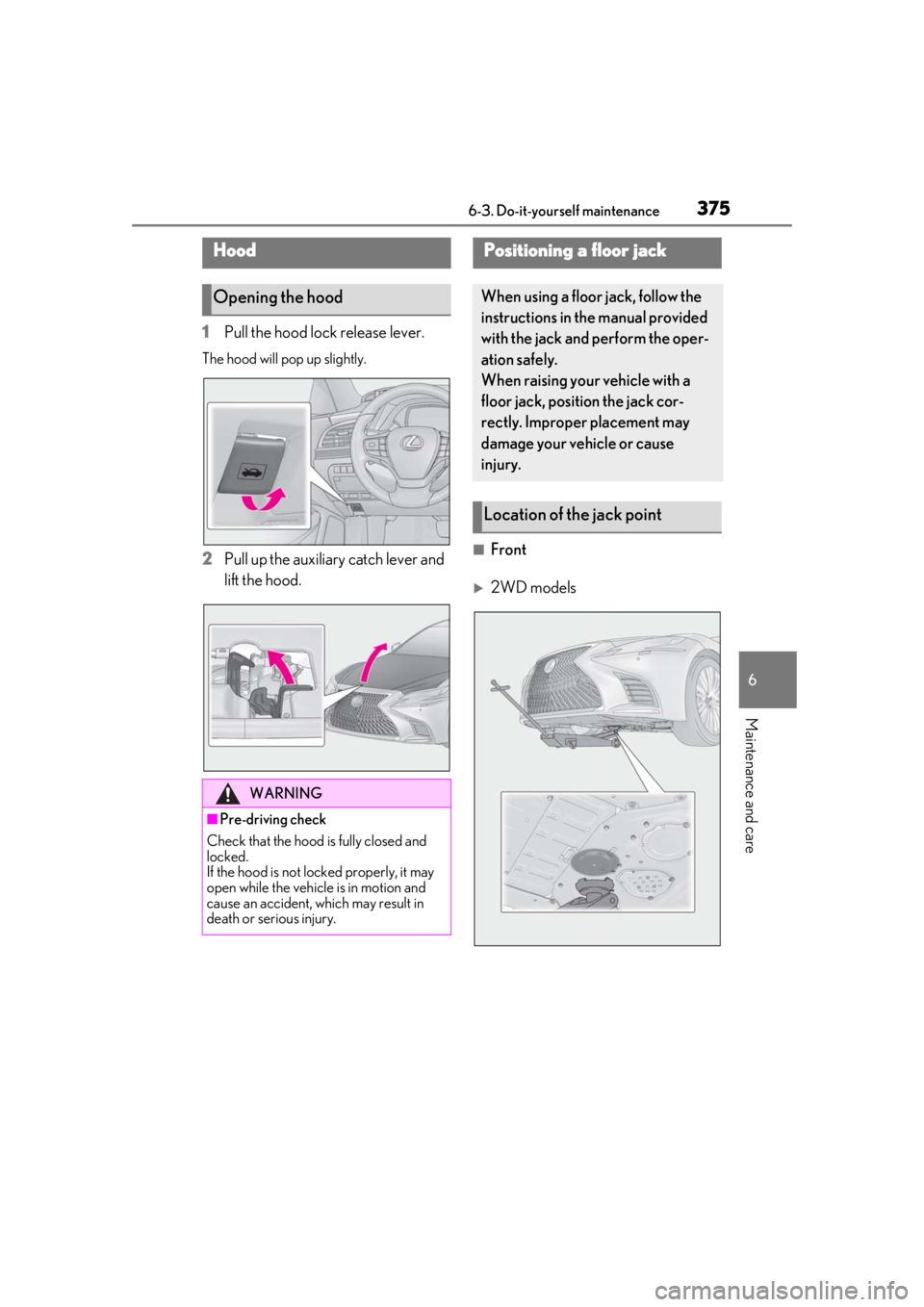
3756-3. Do-it-yourself maintenance
6
Maintenance and care
1Pull the hood lock release lever.
The hood will pop up slightly.
2Pull up the auxiliary catch lever and
lift the hood.■Front
2WD models
Hood
Opening the hood
WARNING
■Pre-driving check
Check that the hood is fully closed and
locked.
If the hood is not locked properly, it may
open while the vehicle is in motion and
cause an accident, which may result in
death or serious injury.
Positioning a floor jack
When using a floor jack, follow the
instructions in the manual provided
with the jack and perform the oper-
ation safely.
When raising your vehicle with a
floor jack, position the jack cor-
rectly. Improper placement may
damage your vehicle or cause
injury.
Location of the jack point